Eye of Providence
The Eye of Providence (or the all-seeing eye of God) is a symbol, having its origin in Christian iconography, showing an eye often surrounded by rays of light or a glory and usually enclosed by a triangle. It represents the eye of God watching over humanity (the concept of divine providence).[1][2][3] In the modern era, a notable depiction of the eye is the reverse of the Great Seal of the United States, which appears on the United States one-dollar bill.

United States
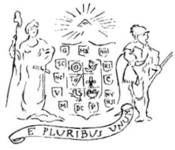
In 1782, the Eye of Providence was adopted as part of the symbolism on the reverse side of the Great Seal of the United States. It was first suggested as an element of the Great Seal by the first of three design committees in 1776 and is thought to be the suggestion of the artistic consultant, Pierre Eugene du Simitiere.[4]
In his original proposal to the committee, Du Simitiere placed the Eye over shields symbolizing each of the original thirteen states of the Union. On the version of the seal that was eventually approved, the Eye is positioned above an unfinished pyramid of thirteen steps (again symbolizing the original States, but incorporating the nation's potential for future growth). The symbolism is explained by the motto that appears above the Eye: Annuit Cœptis, meaning "He approves [our] undertakings" (or "has approved").[5]
Perhaps due to its use in the design of the Great Seal, the Eye has made its way into other American seals and logos, for example: the Seal of Colorado and DARPA's Information Awareness Office.
Brazil

The Eye of Providence was part of the flag and coat of arms adopted by the Confederation of the Equator, a short lived 1824 secessionist revolt in the Northeastern provinces of Brazil.
Freemasonry
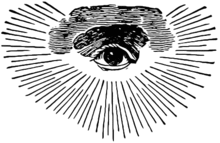
Today the Eye of Providence is often associated with Freemasonry, although it is originally a Christian symbol.[6] The Eye first appeared as part of the standard iconography of the Freemasons in 1797, with the publication of Thomas Smith Webb's Freemasons Monitor.[7] Here, it represents the all-seeing eye of God and is a reminder that humanity's thoughts and deeds are always observed by God (who is referred to in Masonry as the Great Architect of the Universe). Typically, the Masonic Eye of Providence has a semi-circular glory below it. Sometimes this Masonic Eye is enclosed by a triangle.
Popular among conspiracy theorists is the claim that the Eye of Providence shown atop an unfinished pyramid on the Great Seal of the United States indicates the influence of Freemasonry in the founding of the United States. However, common Masonic use of the Eye dates to 14 years after the creation of the Great Seal. Furthermore, among the members of the various design committees for the Great Seal, only Benjamin Franklin was a Mason (and his ideas for the seal were not adopted). Various Masonic organizations have explicitly denied any connection to the creation of the Seal.[8][9]
Religious use
The association of an eye with the concept of Divine Providence did not emerge until well into the Christian era. In Renaissance European iconography, the eye surrounded by a triangle was an explicit image of the Christian Trinity. Seventeenth-century depictions of the Eye of Providence sometimes show it surrounded by clouds or sunbursts.[10] The Eye of God in a triangle is still used in church architecture and Christian art to symbolise the Trinity and God's omnipresence and divine Providence.
In Buddhism, this is one of the higher powers, Abhijñā's, that can be achieved during intensive meditative concentration or samadhi. The Divine Eye, Divine Vision, or in Pali, dibba-cakkhu, allows one to see into the working law of karma. One can 'see' knowing others' karmic destinations; death and subsequent rebirth.
Other uses
Coats of arms and seals
The Eye of Providence also appears on many other coats of arms and official seals, such as:

- The Coat of Arms of Brasłaŭ, Belarus
- The Coat of Arms of Kalvarija, Lithuania
- The Coat of Arms and Flag of Plungė, Lithuania
- The Coat of Arms and Flag of Šiauliai, Lithuania
- The Coat of Arms of Alovė, Lithuania
- The Coat of Arms of Baisiogala, Lithuania
- The Coat of Arms of Wilamowice, Poland
- Several college fraternities use the Eye of Providence in their coats of arms or badges, notably Delta Tau Delta, Phi Kappa Psi, Phi Delta Theta and Delta Kappa Epsilon
- The seal of the State of Colorado
- The seal of The University of Mississippi
- The seal of The University of Chile
- The seal of the city of Kenosha, Wisconsin.
Currency
The Eye appears on the following currency:
- United States one-dollar bill, as part of the Great Seal (see above)
- The 50 Estonian krooni note, as part of a depiction of the pipe organ of the Käina church
- The (old) 500 Ukrainian hryvnia note
- The Vermont Copper
- The Nova Constellatio patterns of 1783[11]
- The Nova Constellatio coppers of 1783 and 1785[12]
- Some Immune Columbia issues[13]
Miscellaneous
- On the original publication of the Declaration of the Rights of Man and of the Citizen, which also borrows iconography of the Ten Commandments
- On the front page of the Constitution of Serbia from 1835
- The Kazan Cathedral, St. Petersburg, Russia
- The Salt Lake Temple, Salt Lake City, Utah
- Jesuit Church, Mannheim, Germany
- Insignia of the UK Guards Division created in 1915
- Numerous video games, TV shows, films, books and websites contain depictions of the eye. A common occurrence is in the context of a reference to the Illuminati.
Pictures
 Alchemical woodcut showing the all-seeing eye floating in the sky
Alchemical woodcut showing the all-seeing eye floating in the sky- All-seeing eye in a Cape Dutch gable in Stellenbosch, South Africa
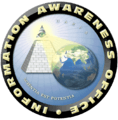 Original seal of the DARPA Information Awareness Office
Original seal of the DARPA Information Awareness Office All-seeing eye on the pedestal decorations of Alexander Column
All-seeing eye on the pedestal decorations of Alexander Column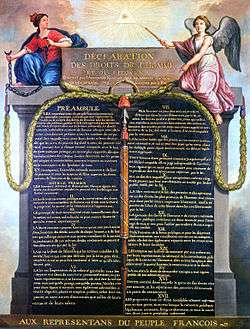 All-seeing eye on the top of the Declaration of Human Rights (1789), French Revolution
All-seeing eye on the top of the Declaration of Human Rights (1789), French Revolution
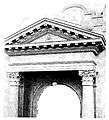 All-seeing eye in a pediment of an esoteric Christian temple in Mount Ecclesia, California
All-seeing eye in a pediment of an esoteric Christian temple in Mount Ecclesia, California- All-seeing eye on the gate of Aachen Cathedral
 Eye of Providence on the exterior of a cathedral in Salta, Argentina
Eye of Providence on the exterior of a cathedral in Salta, Argentina- Eye of Providence depicted on altar equipment, now in a museum in Pala, Kerala state, India
 Eye of Providence depicted in the stained glass window of a church in Fifield, Wisconsin
Eye of Providence depicted in the stained glass window of a church in Fifield, Wisconsin God eye in West Ukraine (Ukrainian Carpathian) near village Mykulychyn. The inscription on the stone, translated from an old Ukrainian dialect into English reads: "All will pass but God's eye does not pass you."
God eye in West Ukraine (Ukrainian Carpathian) near village Mykulychyn. The inscription on the stone, translated from an old Ukrainian dialect into English reads: "All will pass but God's eye does not pass you."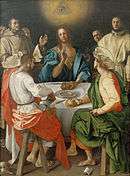 Supper at Emmaus, a 1525 Jacopo Pontormo painting using the Eye of Providence in a triangle as a symbol of the Christian Trinity
Supper at Emmaus, a 1525 Jacopo Pontormo painting using the Eye of Providence in a triangle as a symbol of the Christian Trinity Eye of Providence, Jewish cemetery in Kamienna Góra
Eye of Providence, Jewish cemetery in Kamienna Góra- Eye of Providence in the canting arms of the Jauch family (motto: "Lord thou shalt guide me with thy counsel", Psalm 73:24)
 All seeing eye cross
All seeing eye cross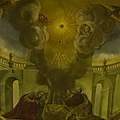
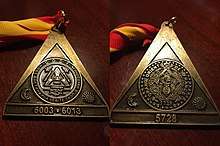 The Eye of Providence depicted on a medallion issued by the Masonic Lodge "Vistina – La Verite" in Skopje, the Republic of Macedonia
The Eye of Providence depicted on a medallion issued by the Masonic Lodge "Vistina – La Verite" in Skopje, the Republic of Macedonia
See also
- Caodaism
- Eye of Horus
- Eye of Ra
- Third eye
References
- "The eye as a Christian symbol". catholic-saints.com.
- "The Eye as a religious symbol". Religiousfacts.com.
- "Freemasonry and the All-seeing Eye". Grand Lodge of British Columbia and Yukon.
- The Great Seal of the United States booklet, published by US Dept. of State
- Greatseal.com: America's Number On the Great Seal
- The eye as a catholic symbol, at www.catholic saints.info
- S. Brent Morris, "The Eye in the Pyramid," from the Short Talk Bulletin of the Masonic Service Association of the United States. Last revised: 01/13/2010 22:34:20. Retrieved 4 March 2015.
- "Anti-masonry Frequently Asked Questions". Grand Lodge of British Columbia and Yukon.
- Barrett, David, W.Bro. "The "Masonic" One Dollar: Fact or Fiction?". Pietre-Stones Review of Freemasonry.
- Potts, Albert M. (1982). The World's Eye. University Press of Kentucky. pp. 68–78. ISBN 978-0-8131-3130-6.
- Lost & Found: The Nova Constellatio Set, retrieved 2019-08-09
- "Constellatio Nova Coppers - Introduction". coins.nd.edu. Retrieved 2019-08-09.
- "Immunis Columbia Copper (backdated) 1787: Introduction". coins.nd.edu. Retrieved 2019-08-09.
External links
